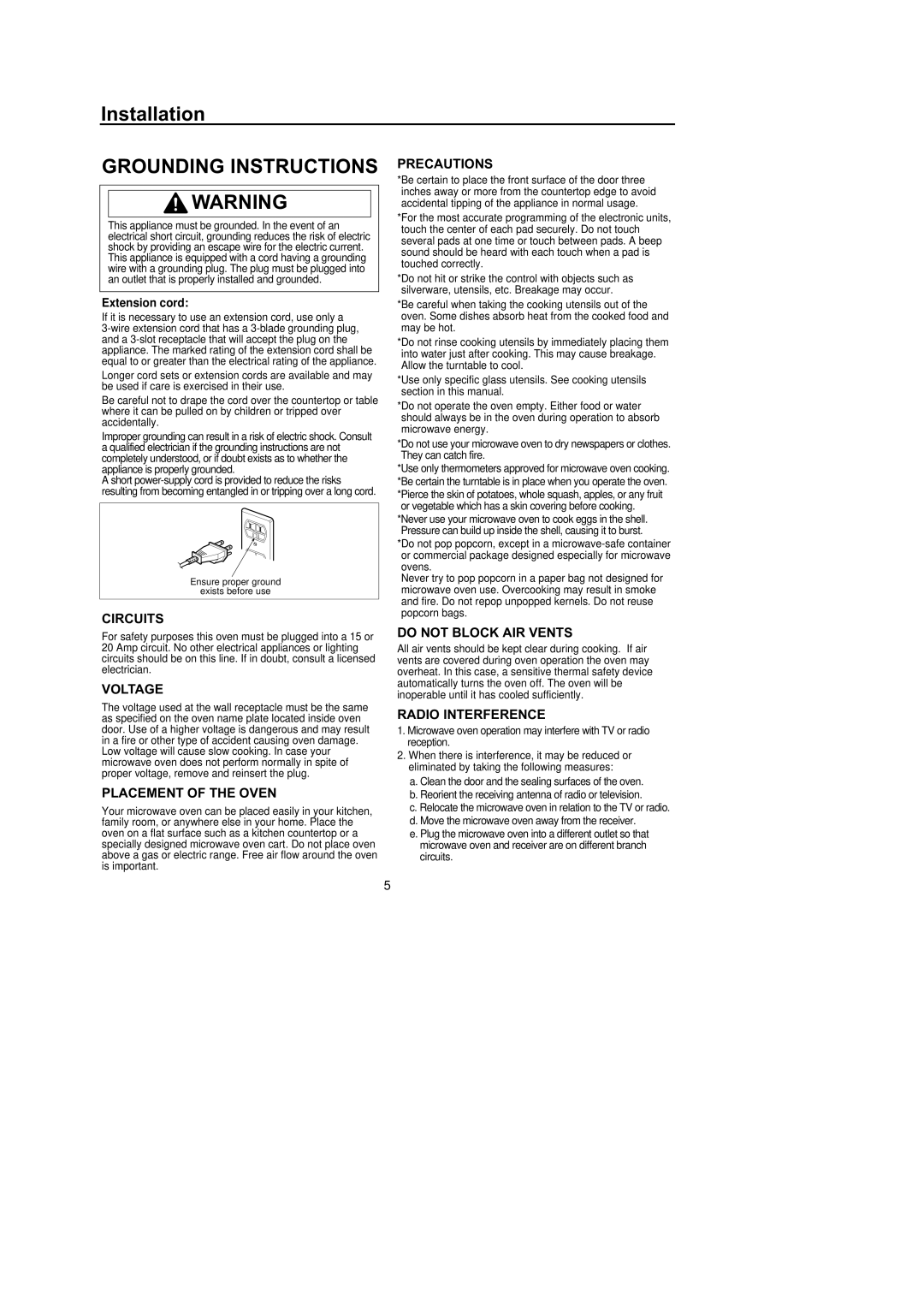
Installation
GROUNDING INSTRUCTIONS
![]() WARNING
WARNING
This appliance must be grounded. In the event of an electrical short circuit, grounding reduces the risk of electric shock by providing an escape wire for the electric current. This appliance is equipped with a cord having a grounding wire with a grounding plug. The plug must be plugged into an outlet that is properly installed and grounded.
PRECAUTIONS
*Be certain to place the front surface of the door three inches away or more from the countertop edge to avoid accidental tipping of the appliance in normal usage.
*For the most accurate programming of the electronic units, touch the center of each pad securely. Do not touch several pads at one time or touch between pads. A beep sound should be heard with each touch when a pad is touched correctly.
*Do not hit or strike the control with objects such as silverware, utensils, etc. Breakage may occur.
Extension cord:
If it is necessary to use an extension cord, use only a
Longer cord sets or extension cords are available and may be used if care is exercised in their use.
Be careful not to drape the cord over the countertop or table where it can be pulled on by children or tripped over accidentally.
Improper grounding can result in a risk of electric shock. Consult a qualified electrician if the grounding instructions are not completely understood, or if doubt exists as to whether the appliance is properly grounded.
A short
Ensure proper ground
exists before use
CIRCUITS
For safety purposes this oven must be plugged into a 15 or 20 Amp circuit. No other electrical appliances or lighting circuits should be on this line. If in doubt, consult a licensed electrician.
VOLTAGE
The voltage used at the wall receptacle must be the same as specified on the oven name plate located inside oven door. Use of a higher voltage is dangerous and may result in a fire or other type of accident causing oven damage. Low voltage will cause slow cooking. In case your microwave oven does not perform normally in spite of proper voltage, remove and reinsert the plug.
PLACEMENT OF THE OVEN
Your microwave oven can be placed easily in your kitchen, family room, or anywhere else in your home. Place the oven on a flat surface such as a kitchen countertop or a specially designed microwave oven cart. Do not place oven above a gas or electric range. Free air flow around the oven is important.
*Be careful when taking the cooking utensils out of the oven. Some dishes absorb heat from the cooked food and may be hot.
*Do not rinse cooking utensils by immediately placing them into water just after cooking. This may cause breakage. Allow the turntable to cool.
*Use only specific glass utensils. See cooking utensils section in this manual.
*Do not operate the oven empty. Either food or water should always be in the oven during operation to absorb microwave energy.
*Do not use your microwave oven to dry newspapers or clothes. They can catch fire.
*Use only thermometers approved for microwave oven cooking. *Be certain the turntable is in place when you operate the oven. *Pierce the skin of potatoes, whole squash, apples, or any fruit or vegetable which has a skin covering before cooking. *Never use your microwave oven to cook eggs in the shell. Pressure can build up inside the shell, causing it to burst.
*Do not pop popcorn, except in a
Never try to pop popcorn in a paper bag not designed for microwave oven use. Overcooking may result in smoke and fire. Do not repop unpopped kernels. Do not reuse popcorn bags.
DO NOT BLOCK AIR VENTS
All air vents should be kept clear during cooking. If air vents are covered during oven operation the oven may overheat. In this case, a sensitive thermal safety device automatically turns the oven off. The oven will be inoperable until it has cooled sufficiently.
RADIO INTERFERENCE
1.Microwave oven operation may interfere with TV or radio reception.
2.When there is interference, it may be reduced or eliminated by taking the following measures:
a.Clean the door and the sealing surfaces of the oven.
b.Reorient the receiving antenna of radio or television.
c.Relocate the microwave oven in relation to the TV or radio.
d.Move the microwave oven away from the receiver.
e.Plug the microwave oven into a different outlet so that microwave oven and receiver are on different branch circuits.
5
